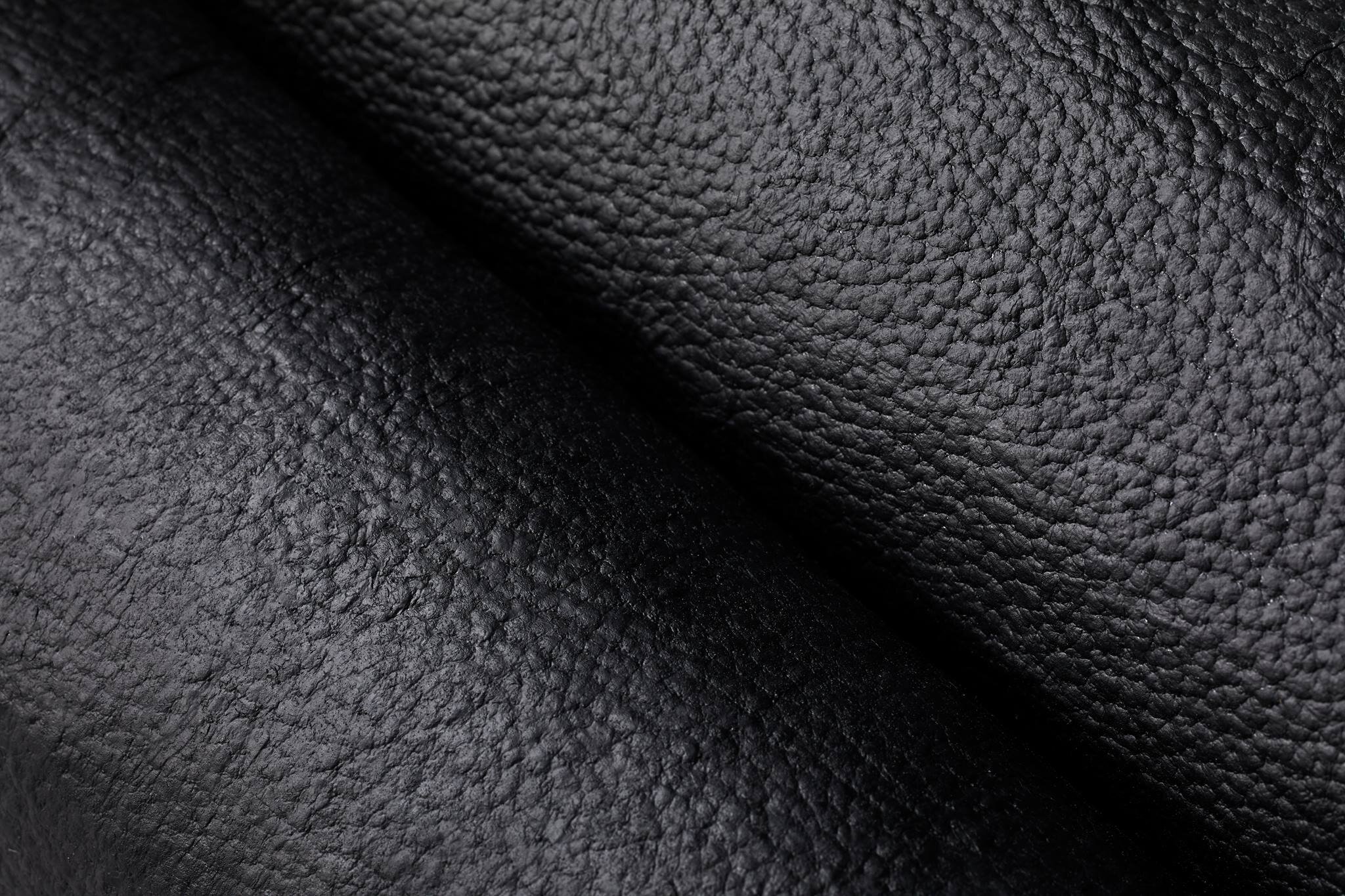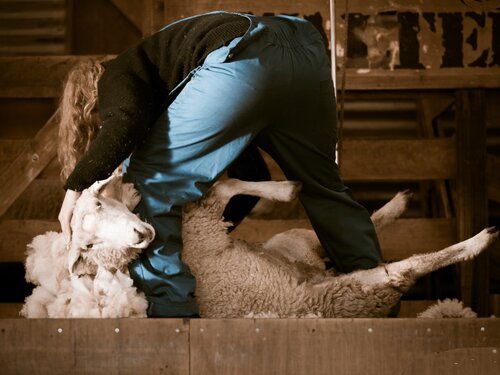Slaughterhouse workers’ suffering in fashion supply chains
Most of us couldn’t bear to hurt an animal, let alone kill one. When we buy animal-derived clothing, we’re paying someone else to do it for us.
Please note this section mentions suic*de.
No one really wants to work in a slaughterhouse,
so the vulnerable are made to do it.
Upwards of 62% of slaughterhouse workers in the United Kingdom are migrants. In the United States, a large portion of these workers are also migrants, refugees and oppressed people of colour. Often undocumented, these workers are less able to stand up for themselves in fear of deportation.
In Australia [PDF 851KB], migrant and refugee slaughterhouse workers from non-English speaking countries and workers with low education levels are common. In Canada, ‘express entry’ to the country was offered to any Syrian refugee who would work in a slaughterhouse.
These jobs are dangerous.
Injuries
In the United Kingdom, an average of two slaughterhouse workers are injured every week. Over six years of documentation, 800 workers suffered serious injuries, with 78 amputations being required and 4 people dying. Health and Safety Executive labelled the industry one of top concern.
In the United States, one quarter of slaughterhouse workers are ill or injured at any one time. Human Rights Watch referred to their factory job as the most dangerous in the country. Here, there are two amputations required each week.
Deaths
Human deaths are not uncommon in slaughterhouses. Slaughter lines are constantly being made to be faster [PDF 415KB] for the sake of profit, at the risk of those wielding sharp and dangerous weapons and tools. It also means that animals are more likely to be slaughtered while fully conscious after being ineffectively stunned.
One sombre example of worker death is that of Lê Tuấn Nhã, a 45-year-old migrant father who was crushed and killed at work in an abattoir while using damaged machinery that had been left unfixed.
Image: via CIVIL EATS
Workers in slaughterhouses are exploited and treated as expendable. While the non-human animals being killed pay the ultimate price, the treatment of these humans is not acceptable either.
Reports have shown slaughterhouse workers wearing diapers because they were denied toilet breaks. Despite claims of ‘multiculturalism at its best’, migrants and refugees in Australian slaughterhouses have been reported to be underpaid and put into extortionate rental accommodation that is over-crowded with workers.
During the COVID-19 crisis, slaughterhouse workers have been far more likely to get sick and even die during the pandemic. Managers of a slaughterhouse even placed bets on which workers would get sick.
Slaughterhouses profit from the death of non-human animals and the exploitation of those who must complete this horrific work.
It’s not only physical injury that impacts slaughterhouse workers.
Perpetration-induced stress disorder
Perpetration-induced traumatic stress (PITS) is similar to PTSD with a fundamental difference: the trauma and stress comes not from being a victim, but being ‘the direct reason for another being’s trauma’. Suffered by soldiers and slaughterhouse workers alike, symptoms, as with PTSD, include ‘drug and alcohol abuse, anxiety, panic, depression, increased paranoia, a sense of disintegration, dissociation or amnesia, which are incorporated into the “psychological consequences” of the act of killing.’
Killing gentle creatures like sheep, cattle and ducks is not what anyone dreams of doing when they grow up. Slaughtering and butchering the carcasses of living beings is distressing, and has serious emotional and mental consequences.
Illustration by Katie Horwich for BBC
Suicide
The mental impact of slaughtering can, unfortunately, lead to thoughts of suicide or the act itself. A harrowing recount of life in a slaughterhouse was shared on the BBC, in which a worker stated: ‘I personally suffered from depression, a condition exacerbated by the long hours, the relentless work, and being surrounded by death. After a while, I started feeling suicidal.’
Later on in the write up, this anonymous worker shares that one co-worker who often made jokes about ‘not being here in six months’ broke down, sobbing as he shared his suicidal thoughts. A few months after the anonymous worker left the slaughterhouse, he heard that a past co-worker had killed himself.
Illustration by Katie Horwich for BBC
An article in The Yale Global Health Review cites a study that refers to a ‘spillover’ of violence from slaughterhouses to the communities surrounding them. Paid to act violently towards non-human animals, these traumatised workers start to lash out at those around them, both at work and at home.
Data has shown that across 500 US counties, communities surrounding slaughterhouses fall victim to disproportionately high numbers of violent offences, including sexual assault and rape. Violence against women is unacceptable and not justified by the perpetrator being traumatised, but it is critical we understand the root of the problem to fix it and protect us all.
From ex-slaughterhouse workers themselves:
“My boss and co-workers resorted to drugs and alcohol consumption after their shifts. My boss’s wife hid her black eyes behind dark sunglasses. We all directed our attention away from her plight: The abuse she was facing at the hands of someone who was supposed to care for her — the same way we had to ignore the animals we were charged with killing.
If compassion were a muscle, this work we did left it weak and atrophied.”
— Susana Chavez
“I needed that job. In a country town, jobs are not really readily available like in the city… So, I stuck with it, I desensitised myself, picked up addictions such as drugs and alcohol to help me cope and go through it… It’s very common in the industry.
The most disturbing moment was killing my first animal. Traumatic. I didn’t like it. I didn’t feel comfortable doing it at all. I had to suppress the emotions.”
— Craig Whitney, to CFJ’s founder
“I'll never forget the day, after I'd been at the abattoir for a few months, when one of the lads cut into a freshly killed cow to gut her - and out fell the foetus of a calf. She was pregnant. He immediately started shouting and throwing his arms about.
I took him into a meeting room to calm him down - and all he could say was, "It's just not right, it's not right," over and over again. These were hard men, and they rarely showed any emotion. But I could see tears prickling his eyes.”
— Anonymous

No ethical supply chain involves killing.
Fashion made of animals funds slaughterhouses and the injustices inside them.
Want to keep learning?
-

Herders and shearers
While shearers face illegal mistreatment, herders report feeling trapped in an industry destroying their native land for wool and cashmere.
-

#WhoKilledForMyClothes?
Animal-derived fashion materials would not exist without farm workers, slaughterhouse workers, or animals and their bodies themselves.
-

Farm workers
Raising animals for exploitation and slaughter has serious mental health impacts for many farmers. The mental distress that comes with such violent work is immense.







